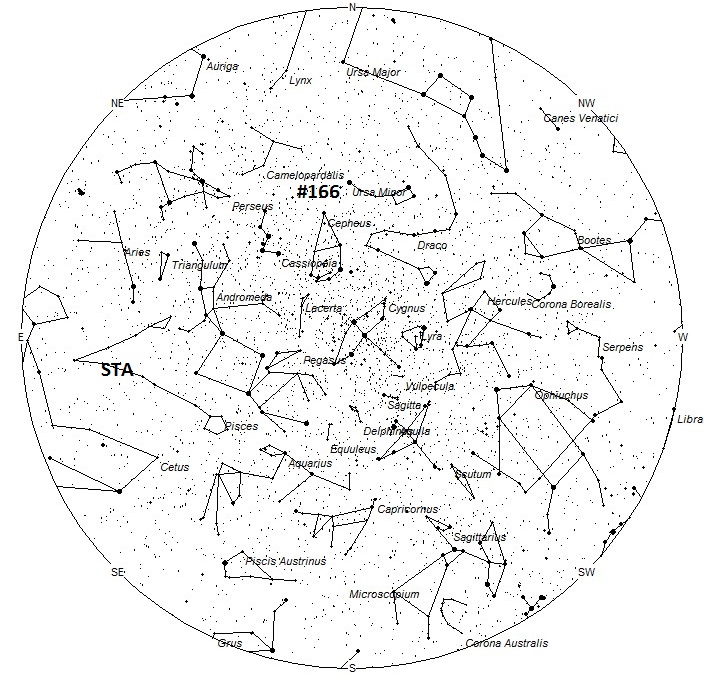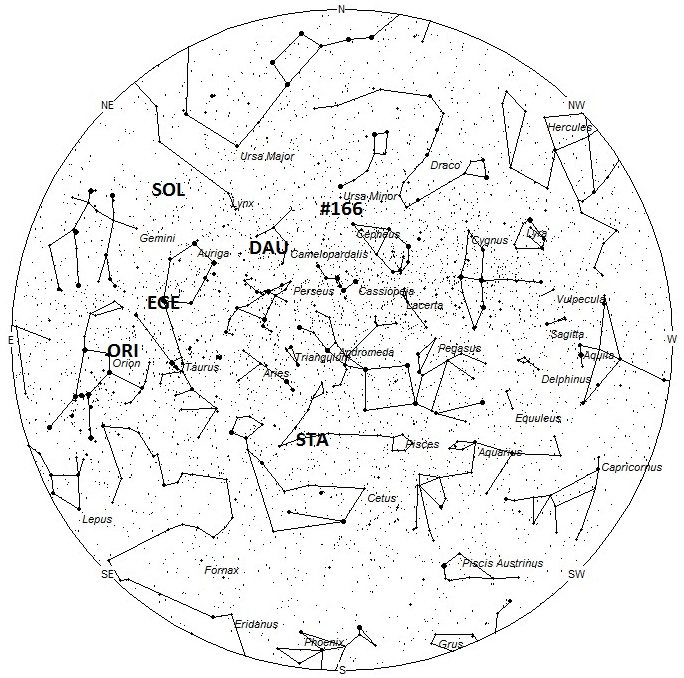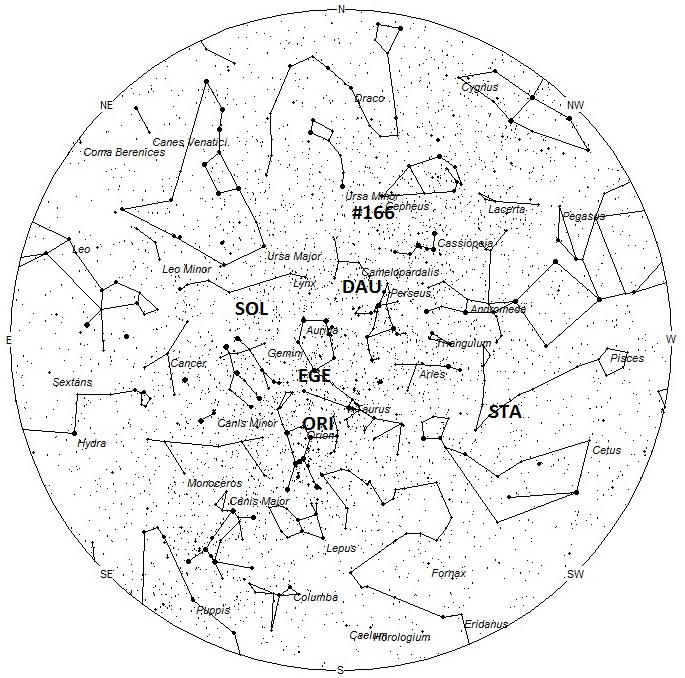Meteor activity in general increases in October when compared to September. A major shower (the Orionids) is active most of the month along with many minor showers. Both branches of the Taurids become more active as the month progresses, providing slow, graceful meteors to the nighttime scene. The Orionids are the big story of the month reaching maximum activity on the 22nd. This display can be seen equally well from both hemispheres which definitely helps out observers located in the sporadic-poor southern hemisphere this time of year.
During this period the moon wanes from just past its last quarter phase to nearly its new phase. This weekend the waning crescent moon will rise a few hours after midnight and will interfere with meteor observing if one looks in the same direction as the moon. The moon becomes less of a problem with each passing night as it gets thinner and rises later each morning. Toward the end of the week it will be no factor at all. The estimated total hourly meteor rates for evening observers this week is near four for observers located in the northern hemisphere and three for those viewing south of the equator. For morning observers the estimated total hourly rates should be near thirteen as seen from mid-northern latitudes and near eight for observers viewing from tropical southern latitudes. Morning rates during this period are reduced due to moonlight. The actual rates will also depend on factors such as personal light and motion perception, local weather conditions, alertness and experience in watching meteor activity. Note that the hourly rates listed below are estimates as viewed from dark sky sites away from urban light sources. Observers viewing from urban areas will see less activity as only the brightest meteors will be visible from such locations.
The radiant (the area of the sky where meteors appear to shoot from) positions and rates listed below are exact for Saturday night/Sunday morning September 28/29. These positions do not change greatly day to day so the listed coordinates may be used during this entire period. Most star atlases (available at science stores and planetariums) will provide maps with grid lines of the celestial coordinates so that you may find out exactly where these positions are located in the sky. A planisphere or computer planetarium program is also useful in showing the sky at any time of night on any date of the year. Activity from each radiant is best seen when it is positioned highest in the sky, either due north or south along the meridian, depending on your latitude. It must be remembered that meteor activity is rarely seen at the radiant position. Rather they shoot outwards from the radiant so it is best to center your field of view so that the radiant lies at the edge and not the center. Viewing there will allow you to easily trace the path of each meteor back to the radiant (if it is a shower member) or in another direction if it is a sporadic. Meteor activity is not seen from radiants that are located below the horizon. The positions below are listed in a west to east manner in order of right ascension (celestial longitude). The positions listed first are located further west therefore are accessible earlier in the night while those listed further down the list rise later in the night.
The following sources of meteoric activity are expected to be active this week:
IMO #166 is a weak display active from September 19-29. Maximum activity occurred on the 24th when rates were still expected to be less than one shower member per hour. The current position of this radiant lies at 00:28 (007) +82. This position lies in northern Cepheus, five degrees northwest of the third magnitude star known as Errai (Gamma Cephei). The radiant is best placed near 0100 local daylight time (LDT), when it lies highest above the horizon. With an entry velocity of 39 km/sec., most activity from this radiant would be swift of medium velocity. Due to the extreme northern location of this radiant, these meteors are only visible from the northern hemisphere.
The Southern Taurids (STA) are currently active from a radiant located at 01:32 (023) +07. This position lies in southeastern Pisces, close to the spot occupied by the faint star Mu Piscium. These meteors may be seen all night long but the radiant is best placed near 0200 local daylight time (LDT) when it lies on the meridian and is located highest in the sky. Rates at this time should be near one per hour regardless of your location. With an entry velocity of 29 km/sec., the average Southern Taurid meteor would be of slow velocity.
The last of the Delta Aurigids (DAU) are expected this weekend from a radiant located at 04:52 (073) +55. This position is actually located in southern Camelopardalis, 10 degrees northwest of the brilliant zero magnitude star known as Capella (Alpha Aurigae). Rates of less than 1 per hour are expected, no matter your location. These meteors are best seen near 0500 LDT when the radiant lies highest in the sky. With an entry velocity of 63 km/sec., most activity from this radiant would be of swift speed.
The Orionids (ORI) are active from a radiant at 05:28 (082) +11, which places it in northwestern Orion, 5 degrees north of the second magnitude star known as Bellatrix (Gamma Orionis). This area of the sky is best placed in the sky during the last hour before dawn, when it lies highest above the horizon in a dark sky. Rates this week would be near 2 per hour no matter your location. With an entry velocity of 67 km/sec., most activity from this radiant would be of swift speed.
Recent analysis of the IMO video database has shown that the Epsilon Geminids (EGE) are active as early as September 22. The current radiant position would be located near 05:36 (084) +28, which places it in northern Taurus, just southeast of the second magnitude star known as El Nath (Beta Tauri). This area of the sky is best placed in the sky during the last hour before dawn, when it lies highest above the horizon in a dark sky. Current rates would be near 1 per hour as seen from the northern hemisphere and less than 1 when view south of the equator. With an entry velocity of 70 km/sec., most activity from this radiant would be of swift speed.
The September-October Lyncids (SOL) are only well seen on 3 nights centered on September 29th. Maximum occurs on the 30th when the radiant is located at 07:24 (111) +47. This position lies in western Lynx, 12 degrees north of the second magnitude star known as Castor (Alpha Geminorum). This area of the sky is best placed in the sky during the last hour before dawn, when it lies highest above the horizon in a dark sky. Rates at maximum are expected to be near one shower member per hour as seen from the northern hemisphere. These meteors can be seen from the tropical southern hemisphere but rates would be less than one per hour. With an entry velocity of 67 km/sec., most activity from this radiant would be of swift speed.
As seen from the mid-northern hemisphere (45N) one would expect to see approximately eight sporadic meteors per hour during the last hour before dawn as seen from rural observing sites. Evening rates would be near three per hour. As seen from the tropical southern latitudes (25S), morning rates would be near five per hour as seen from rural observing sites and two per hour during the evening hours. Locations between these two extremes would see activity between the listed figures. Morning rates are reduced due to moonlight.
The table below presents a list of radiants that are expected to be active this week. Rates and positions are exact for Saturday night/Sunday morning except where noted in the shower descriptions.
| SHOWER | DATE OF MAXIMUM ACTIVITY | CELESTIAL POSITION | ENTRY VELOCITY | CULMINATION | HOURLY RATE | CLASS |
| RA (RA in Deg.) DEC | Km/Sec | Local Daylight Time | North-South | |||
| IMO #166 | Sep 24 | 00:28 (007) +82 | 39 | 01:00 | <1 – <1 | IV |
| Southern Taurids (STA) | Oct 10 | 01:32 (023) +07 | 29 | 02:00 | 1 – 1 | II |
| Delta Aurigids (DAU) | Sep 25 | 04:52 (073) +55 | 63 | 05:00 | <1 – <1 | IV |
| Orionids (ORI) | Oct 22 | 05:28 (082) +11 | 67 | 06:00 | 2 – 2 | I |
| Epsilon Geminids (EGE) | Oct 22 | 05:36 (084) +28 | 70 | 06:00 | 1 – <1 | II |
| Sep-Oct Lyncids (SOL) | Sep 30 | 07:24 (111) +47 | 67 | 08:00 | 1 – <1 | IV |
 American Meteor Society
American Meteor Society



I saw a meteor yesterday while i was dove hunting in south carolina yesterday
Probably one of dozens, but it was daylight, nearly noon Friday, Sept 27. A tiny fireball over So CT. Only lasted a few seconds, probably vaporized. DIdn’t realize you had a website until today, or just wasn’t thinking about it.
Knew what it was though!
I was taking my kids to school this morning. All three of us saw a large fireball falling downward with a come shape tail. We were blown away I have never witnessed something like that. We were on exit 1 heading toward Augusta Georgia.